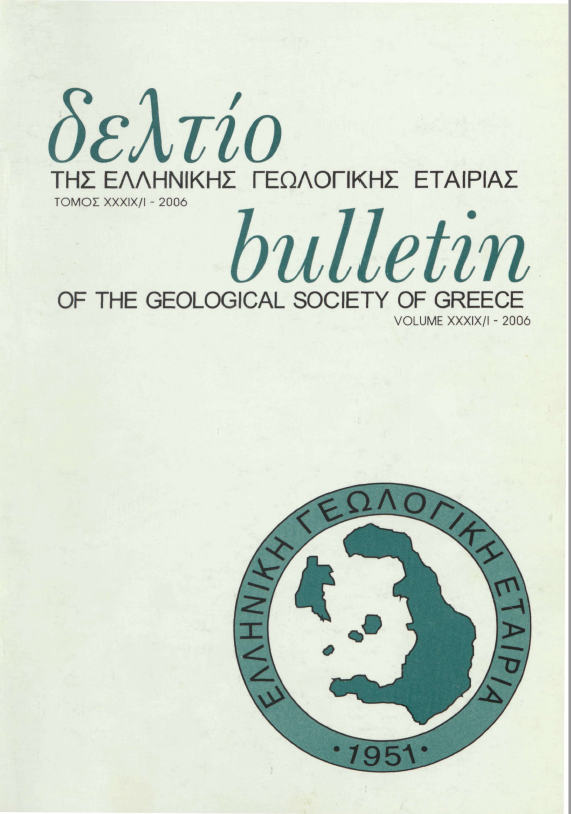TECTONO-SEDIMENTARY EVOLUTION AND RATES OF TECTONIC UPLIFT OF THE SFAKIA COASTAL ZONE, SOUTHWESTERN CRETE

Περίληψη
Η περιοχή των Σφακιών είναι μία στενή παράκτια ζώνη στο νοτιοδυτικό τμήμα των Λευκών Ορέων, στο οποίο διασώζεται τμήμα του Νότιου Κρητικού περιθωρίου. Πρόκειται για μία μακρόχρονη νεοτεκτονική δομή που άρχισε τη δράση της στο Ανώτερο Μειόκαινο και συνεχίζεται μέχρι σήμερα. Χαρακτηρίζεται από μία απότομη μορφολογική ασυνέχεια διεύθυνσης Α-Δ, που σχηματίστηκε από ρήγματα διεύθυνσης Α-Δ και ΑΝΑ-ΔΒΔ προκαλώντας εφελκυσμό Β-Ν. Από το Ανώτερο Μειόκαινο μέχρι το Κατώτερο Π?.ειστόκαινο αποτέθηκαν θαλάσσια, ενώ ακολούθως η ιζηματογένεση συνεχίστηκε με την απόθεση μεγά).ου πάχους αλλουβιακών ριπιδιών, διαδικασία που συνεχίζεται μέχρι σήμερα. Η καλύτερη στοιχειοθέτηση της ηλικίας των θαλάσσιων ιζημάτων σε συνδυασμό με πρόσφατα δημοσιεύματα σχετικά με το βάθος απόθεσης τους και με τη χαρτογράφηση των ρηγμάτων της περιοχής, έδωσε τη δυνατότητα να προβούμε σε σημαντικές διαπιστώσεις σχετικά με τους μακροχρόνιους ρυθμούς ανύψωσης των ρηξιτεμαχών της περιοχής, όπως και για το χρονικό διάστημα που τα ρήγματα που ορί- ζουν αυτά τα ρηξιτεμάχη ήταν ενεργά. Από το Μέσο Πλειόκαινο όλη η περιοχή υπόκειται σε ανύψωση με τις εσωτερικές περιοχές να έχουν ρυθμούς έως και διπλάσιους από εκείνους της παράκτιας ζώνης. Η γενική ανύψωση φαίνεται να ελέγχεται από ρήγματα υποθαλάσσια νότια της περιοχής μελέτης.
Λεπτομέρειες άρθρου
- Πώς να δημιουργήσετε Αναφορές
-
Skourtsos, E., Pope, R., & Triantaphyllou, M. V. (2007). TECTONO-SEDIMENTARY EVOLUTION AND RATES OF TECTONIC UPLIFT OF THE SFAKIA COASTAL ZONE, SOUTHWESTERN CRETE. Δελτίο της Ελληνικής Γεωλογικής Εταιρείας, 40(1), 475–487. https://doi.org/10.12681/bgsg.16649
- Ενότητα
- Tectonic- Dynamic- Applied Geology

Αυτή η εργασία είναι αδειοδοτημένη υπό το CC Αναφορά Δημιουργού – Μη Εμπορική Χρήση 4.0.
Οι συγγραφείς θα πρέπει να είναι σύμφωνοι με τα παρακάτω: Οι συγγραφείς των άρθρων που δημοσιεύονται στο περιοδικό διατηρούν τα δικαιώματα πνευματικής ιδιοκτησίας επί των άρθρων τους, δίνοντας στο περιοδικό το δικαίωμα της πρώτης δημοσίευσης. Άρθρα που δημοσιεύονται στο περιοδικό διατίθενται με άδεια Creative Commons 4.0 Non Commercial και σύμφωνα με την οποία μπορούν να χρησιμοποιούνται ελεύθερα, με αναφορά στο/στη συγγραφέα και στην πρώτη δημοσίευση για μη κερδοσκοπικούς σκοπούς. Οι συγγραφείς μπορούν να: Μοιραστούν — αντιγράψουν και αναδιανέμουν το υλικό με κάθε μέσο και τρόπο, Προσαρμόσουν — αναμείξουν, τροποποιήσουν και δημιουργήσουν πάνω στο υλικό.



